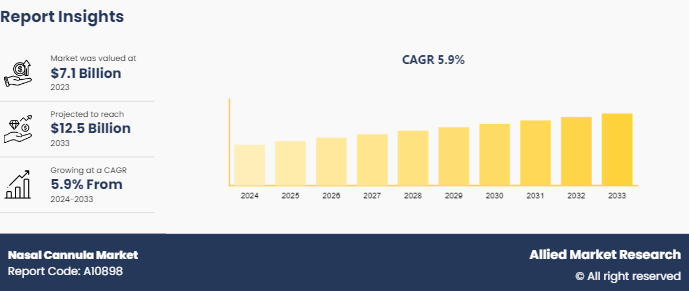Nasal Cannula Market Research, 2033
The global nasal cannula market size was valued at $7.1 billion in 2023 and is projected to reach $12.5 billion by 2033, growing at a CAGR of 5.9% from 2024 to 2033.

Market Introduction
A nasal cannula is a crucial medical device utilized for administering supplemental oxygen therapy directly through the nose. Comprised of a slender, pliable tube encircling the head and extending into the nostrils, it features two prongs that deliver oxygen. Connected to an oxygen source such as a tank or container, it comes in two primary variants: high-flow nasal cannulas (HFNC) and low-flow nasal cannulas (LFNC) , distinguished by the volume and type of oxygen they dispense per minute. Vital for individuals experiencing respiratory distress or insufficient oxygen intake, a nasal cannula facilitates the delivery of essential oxygen to sustain organ function.
Key Takeaways
- The nasal cannula market size analysis covers 20 countries. The research includes a segment analysis of each country in terms of value ($billion) for the projected period from 2024 to 2033.
- More than 1, 500 product literatures, industry releases, annual reports, and other such documents of major nasal cannula industry participants along with authentic industry journals, trade associations' releases, and government websites have been reviewed for generating high-value industry insights.
- The study integrates high-quality data, professional opinions and analysis, and critical independent perspectives. The research approach intends to provide a balanced view of global markets and assist stakeholders in making informed decisions in order to achieve their most ambitious growth objectives.
Key Market Dynamics
The nasal cannula market share, particularly high-flow variants, is being driven by several key factors. For instance, the ability of nasal cannulas to provide supplemental oxygen without obstructing speech or eating enhances patient comfort and compliance, driving their adoption. Also, the benefits of nasal cannulas, such as improved breathing, reduced fatigue, better sleep quality, and increased energy levels, significantly enhance patients' quality of life, making them a preferred choice for oxygen therapy. These factors collectively contribute to the rising demand for nasal cannulas, driving market growth and innovation in oxygen therapy solutions.
However, the nasal cannula market faces certain challenges in accurately placing the cannula, during nose remodeling with fillers, potentially leading to adverse events. Some designs lack nostril prongs, impacting oxygen delivery efficiency. High-flow nasal cannulas offer enhanced comfort and humidification but may cause discomfort due to high flow and warm air sensation. They can also generate aerosols, potentially increasing viral transmission risk. These factors are anticipated to restrain the nasal cannula market growth in the coming years.
The extensive research and clinical evaluations surrounding high flow nasal oxygen (HFNO) present significant opportunities for the nasal cannula market players. As HFNO emerges as a promising modality for treating various types of respiratory failure, including Type I, II, III, and IV, there is a rising need for innovative nasal cannula designs that cater to the specific requirements of HFNO therapy. Opportunities lie in developing nasal cannulas that are compatible with high flow rates, provide optimal comfort, and ensure accurate delivery of oxygen concentrations. These factors are anticipated to have positive impact on the nasal cannula market opportunity.
Analysis of Global Nasal Cannula Industry
Nasal cannula is a medical device used to deliver supplemental oxygen to individuals with respiratory diseases such as asthma and COPD. Increase in the prevalence of asthma especially in the U.S. is driving the demand for nasal cannula.
Below is the tabular representation of the statistics on Asthma in the U.S., as stated by American College of Allergy, Asthma & Immunology, in June 2023
Aspect | Statistics |
Total Asthma Prevalence in the U.S. | 7.7% |
Total Asthma Cases | Approximately 24.9 million (20.2 million adults, 4.6 million children) |
Asthma Prevalence in Adults | 8.0% |
Asthma Prevalence in Children | 6.5% |
Asthma Prevalence in Females | 9.7% |
Asthma Prevalence in Males | 6.2% |
Hospital Inpatient Stays due to Asthma | 94,000 |
Emergency Department Visits due to Asthma | >900,000 |
Estimated Economic Cost of Asthma | $50 billion annually |
Annual Asthma-Related Deaths | More than 3,500 (nearly a third aged 65 or older) |
Percentage of People with At Least One Asthma Attack Each Year | 50% (adults: 39.6%, children: 38.7%) |
Percentage of Uncontrolled Asthma | 60% (adults), 44% (children) |
Market Segmentation
The nasal cannula market is segmented into type, material, end user, and region. On the basis of type, the market is divided into low flow nasal cannula and high flow nasal cannula. Based on material, the market is classified into plastic and silicone. Based on end user, the market is divided into hospitals, ambulatory healthcare services, long term care centers, and others. Region wise, the market is analyzed across North America, Europe, Asia-Pacific, and LAMEA.
Country Market Outlook
In the U.S., COPD affects approximately 11.7 million adults, contributing to hundreds of thousands of emergency department visits and substantial healthcare costs annually. It ranks as the sixth leading cause of death, with 138, 825 deaths reported in 2021. COPD primarily impacts older age groups, with 85% of deaths occurring among individuals aged 65 years or older. Symptoms include chronic cough, difficulty breathing, chest tightness, and fatigue, severely affecting patients' daily activities and quality of life.
In addition, in the U.S., the presence of leading nasal cannula manufacturers namely Teleflex, Salter Labs, Westmed, Fisher & Paykel Healthcare, and Vyaire Medical are driving the market expansion. These companies offer a range of nasal cannula products designed to deliver oxygen therapy effectively and comfortably to patients with respiratory conditions such as COPD.
Some of the prominent healthcare service providers offering nasal cannula treatments include like Mayo Clinic, Cleveland Clinic, Johns Hopkins Medicine, and Kaiser Permanente. In addition, home healthcare providers such as Lincare, Apria Healthcare, and Rotech Healthcare offer nasal cannula treatments as part of their comprehensive respiratory care services, ensuring access to oxygen therapy for patients both in clinical settings and in the comfort of their homes. These factors are anticipated to have positive impact on nasal cannula market forecast in the U.S.
Competitive Landscape
The major players operating in the nasal cannula market include Allied Healthcare Products Inc., Teleflex Incorporated, Flexicare Medical Ltd., Vapotherm Inc., ResMed Inc., Fairmont Medical, Fisher & Paykel Healthcare Limited, Well Lead Medical Co. Ltd., Salter Labs, and others.
Recent Key Strategies and Developments
- In June 2023, Flexicare successfully acquired Clement Clarke International (CCI) , a renowned UK-based medical device manufacturer specializing in respiratory solutions. With over a century of expertise, CCI's products, including the acclaimed Peak Flow Meter, are well-known in the industry. Flexicare aims to invest in CCI's portfolio development, leveraging its heritage in respiratory condition diagnosis and treatment. This acquisition further strengthens Flexicare's commitment toward delivering innovative medical devices globally.
- In February 2021, Masimo launched softFlow in the U.S., a high-flow nasal cannula therapy offering warm, humidified respiratory gases to spontaneously breathing patients. softFlow provides a vital tool for respiratory support in various care settings. Utilizing a single-patient-use flow path and bacterial/viral filter to reduce cross-contamination risk, it meets NIH and WHO recommendations for respiratory support. Patients benefit from continuous airflow, enabling normal activities like eating and speaking. Its integrated airflow generator and water reservoir facilitate home use, offering a versatile solution for managing respiratory conditions.
Key Benefits For Stakeholders
- This report provides a quantitative analysis of the market segments, current trends, estimations, and dynamics of the nasal cannula market analysis from 2023 to 2033 to identify the prevailing nasal cannula market opportunities.
- The market research is offered along with information related to key drivers, restraints, and opportunities.
- Porter's five forces analysis highlights the potency of buyers and suppliers to enable stakeholders make profit-oriented business decisions and strengthen their supplier-buyer network.
- In-depth analysis of the nasal cannula market segmentation assists to determine the prevailing market opportunities.
- Major countries in each region are mapped according to their revenue contribution to the global market.
- Market player positioning facilitates benchmarking and provides a clear understanding of the present position of the market players.
Apart from the points mentioned above, the report includes the analysis of the regional as well as global nasal cannula market trends, key players, market segments, application areas, and market growth strategies.
Industry Trends
- In February 2024, Merck Animal Health, the leading pharmaceutical company, unveiled the Allflex CleanVax nozzles and shields, a new system for administering intranasal vaccines to cattle. The system features shorter, less invasive nozzles and disposable shields for improved hygiene and comfort. Designed to optimize the vaccination process, the CleanVax system ensures consistent dosing while minimizing discomfort for calves. These products enhance biosecurity and are compatible with various syringes or applicator guns. Merck Animal Health aims to advance cattle health with innovative vaccination solutions.
- In February 2024, PGIMER’s Anaesthesia Department unveiled TrueOxy+: a groundbreaking high flow nasal cannula device for non-invasive ventilation. This device ensures precise oxygenation levels without invasive intubation, benefiting acute hypoxemic respiratory failure management. With dual adult and pediatric modes, it offers versatility and comfort. TrueOxy+ recently completed phase II testing at PGIMER, demonstrating efficacy and adherence to international standards. Patent filing and certification highlight its potential to revolutionize respiratory care.
Key Sources Referred
- National Institute of Health
- American Lung Association
- Canadian Lung Association
- World Health Organization
- National Library of Medicine
- ELF European Lung Foundation
- National Health Council
- Asthma and Allergy Foundation of America
- National Organization for Rare Disorders, Inc.
- U.S. Department of Health & Human Services
- FIRS
Nasal Cannula Market Report Highlights
| Aspects | Details |
| Market Size By 2033 | USD 12.5 Billion |
| Growth Rate | CAGR of 5.9% |
| Forecast period | 2024 - 2033 |
| Report Pages | 316 |
| By Type |
|
| By Material |
|
| By End User |
|
| By Region |
|
| Key Market Players | Salter Labs, Vapotherm Inc., Flexicare Medical Ltd., Fairmont Medical, ResMed Inc., Allied Healthcare Products Inc., Teleflex Incorporated, Fisher & Paykel Healthcare Limited, Well Lead Medical Co. Ltd. |
Analyst Review
The growing demand for disposable and portable cannulas, driven by increasing respiratory disorders and homecare settings are the upcoming trends in the nasal cannula market.
The leading application of nasal cannual includes its use in hospitals and ambulatory healthcare services.
North America is the largest regional market for nasal cannula.
The global nasal cannula market is estimated to reach $12.5 billion by 2033.
The top companies to hold the major market share in nasal cannula are Allied Healthcare Products Inc., Teleflex Incorporated, Flexicare Medical Ltd., and Vapotherm Inc.
Loading Table Of Content...



